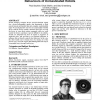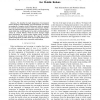82 search results - page 10 / 17 » Spatial reasoning for human robot interaction |
HRI
2009
ACM
14 years 2 months ago
2009
ACM
Several emerging computer devices read bio-electrical signals (e.g., electro-corticographic signals, skin biopotential or facial muscle tension) and translate them into computer- ...
ADBIS
2010
Springer
13 years 9 months ago
2010
Springer
Cardinal directions have turned out to be very important qualitative spatial relations due to their numerous applications in spatial wayfinding, GIS, qualitative spatial reasoning ...
SIGDIAL
2010
13 years 5 months ago
2010
Spoken language interaction between humans and robots in natural environments will necessarily involve communication about space and distance. The current study examines people�...
E4MAS
2005
Springer
14 years 1 months ago
2005
Springer
Stigmergy (the coordination of agents through signs they make and sense in a shared environment) was originally articulated in the study of social insects. Its basic processes are ...
IROS
2007
IEEE
14 years 1 months ago
2007
IEEE
— We describe the tight integration of incremental natural language understanding, goal management, and action processing in a complex robotic architecture, which is required for...


